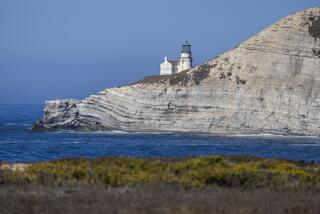Mammoth Lure : Fossil May Boost Traffic to Oft-Deserted Islands
The discovery of a rare pygmy mammoth fossil on Santa Rosa Island could turn the spotlight on a national park that California has yet to discover.
Consistently one of the least visited parks in the state, the Channel Islands National Park will offer sightseers a chance to watch the excavation in progress next week, tour other archeological sites and, eventually, view a fiberglass model of the prehistoric creature.
“The fact that this is happening in our own back yard, I think it will focus attention on the islands and the unique resource that they are,” said Carol Spears, spokeswoman for the park. “The islands are a treasure trove.”
In recent years, the five-island park off the Ventura County coast has yielded Chumash artifacts, prehistoric bones and remnants from 19th-Century shipwrecks.
The latest find may be the most significant. Paleontologists believe it to be the first discovery of a complete pygmy mammoth skeleton in the world.
Like today’s elephants, mammoths were strong swimmers. Scientists theorize that the pygmy mammoth’s ancestors swam to the Channel Islands during the last Ice Age, when the crossing was much narrower. The ancestral elephant was a smaller version of the woolly mammoth that lived in southern California. On the island it evolved into a species that stood 4 to 6 feet high.
The smallest of the breed were about one-third the size of their mainland relatives. Some scientists believe there was more than one species of the mammoth on the islands.
San Diego geologist Tom Rockwell and his student Kevin Colson came across the fossilized remains on June 29 while studying fault lines on the rugged island.
“I knew it was a mammoth at once,” said Rockwell, who teaches at San Diego State University.
The skull, spine and hip of the animal literally stuck out in relief from the sand and ice plant on the eroding hillside, Rockwell said. Scientists believe they will find the tusks and legs beneath the surface.
The bones were too old to belong to a modern-day cow, he said. And the next largest animal on the Channel Islands was a small fox, which grew to about the size of a Yorkshire terrier. “(The find) was definitely not a fox,” he added.
What he didn’t know was that scientists had never found a full pygmy mammoth skeleton before. The full set of bones offers paleontologists a chance to determine more about the appearance of the animal and the species it evolved from.
An excavation team, drawn from universities across the nation, will arrive next week to unearth the rare fossil and preserve the bones for further study. The excavation is expected to take 10 days.
Two paleontologists, Larry Agenbroad and Jim Mead from Northern Arizona University, will focus on the fossilized bones, protecting each with resin and plaster casts. They will later evaluate them at their Arizona laboratory, Mead said.
Rockwell will join the team to evaluate the age of the rock sediment in which he found the fossil. He will collect coral and shell from the site for six months of analysis.
At first glance, he estimated the fossil was between 25,000 and 75,000 years old. Now he said he is leaning toward the 75,000- to 80,000-year range, judging from the sediment around the find.
The sea level on Santa Rosa Island dropped significantly about 70,000 years ago, leaving distinctive markings on the terrain, he said. Today, the fossil lies above a sea cliff that drops about 40 feet to the ocean.
Only about two or three scientists can work on the sloping site at one time, said Morris, the park archeologist. In addition, the crew plans to install a safety net beneath the dig so that no tools--or scientists--slip into the ocean below.
Next week, the park service is offering visitors a chance to watch the dig in progress. But space is limited, as much by the site as by the logistics of bringing visitors to the remote island.
Travel time and cost have always limited visitors to the Channel Islands, which became a national park 13 years ago. National Park Service figures last year showed that the islands received 55,000 visitors, fewer than any federal park in California except Devil’s Postpile near Mammoth Lakes.
Spears said the trend has not changed this year, but hoped that publicity about the mammoth discovery, as well as shipwreck tours and nature walks, will lure more people to the islands.
“We can sponsor paleontological tours,” she said. “We can show people where finds are discovered and how people discovered them.”
And when the scientists finish their dig, they plan to use the bones to create a mold and cast a fiberglass replica of the pygmy mammoth, which would be placed in the park service’s exhibit hall at Ventura Harbor.
The Friends of Channel Islands National Park are planning fund-raising events to provide the $20,000 needed to complete the model.
FYI
Friends of Channel Islands National Park offers visitors a chance to see the excavation of a rare pygmy mammoth fossil. Visitors can take a 3 1/2-hour boat trip to Santa Rosa Island on Aug. 11, or a 25-minute airplane ride on Aug. 13. The boat trip will cost $55 to $70 and can be arranged by calling Island Packers at 642-1393. The plane trip, which will cost $85 to $100, can be arranged by calling 658-5740.
More to Read
Sign up for Essential California
The most important California stories and recommendations in your inbox every morning.
You may occasionally receive promotional content from the Los Angeles Times.










